French Decorative Arts from the Louvre to eBay
Some thoughts on the everyday objects of life and what makes them "art"
Welcome to this week’s edition of Reading Art!
Whenever I get a chance, I love going into the French decorative arts gallery at Getty, which kind of feels to me like a Rococo manic pixie dream IKEA.
It’s almost (ok, extremely) tempting to go sit down in one of those plush chairs and pretend I’m living in a historical drama set in 1700s France. This was a time period in which the aristocracy became even more obsessed with lavish displays of wealth. Not so great from a societal perspective, perhaps, but what a vibe.
French transitional/regency/Rococo rooms are especially fun to stage so that you get a kind of immersive experience of the past. There’s a lot of great ones at museums all over the world, like this one at the Met:
As you’ve probably guessed, the topic of today’s virtual gallery tour is French decorative arts! What are decorative arts, you might ask? Simply put, it’s furniture, vases, ceramics, pottery, glassware, even things like utensils and serving dishes. Unlike paintings and sculptures, the main purpose of these objects is to be functional. It’s true that you can probably think of a family set of china or utensils or napkins or something that were always being “saved” for special occasions, and therefore never used at all in perpetual hope of that “someday” someday coming, but the point is that if you wanted to eat off your wedding set for the rest of your life, you absolutely could.
The utility of these things is offset by their ornate decoration. That’s why we call them art: a creative flair was still needed to produce them. Their beauty does not enhance their usefulness, but we like them better because they are so beautiful.
I’ve been a lifelong fan of French antiques. In my parents’ house, there used to be a small but mighty collection of antique French furniture that someone gave my father decades ago. There were some wood end tables and a large armoire and, best of all, a settee, which is basically a small couch with a high back and winged arm rests. They were all from the eighteenth century, allegedly, which was pretty cool to think about.
Somehow, the only picture I have of my parents’ settee is one in which our dog is laying on it, eagerly waiting for Christmas morning, but it gives you the idea:
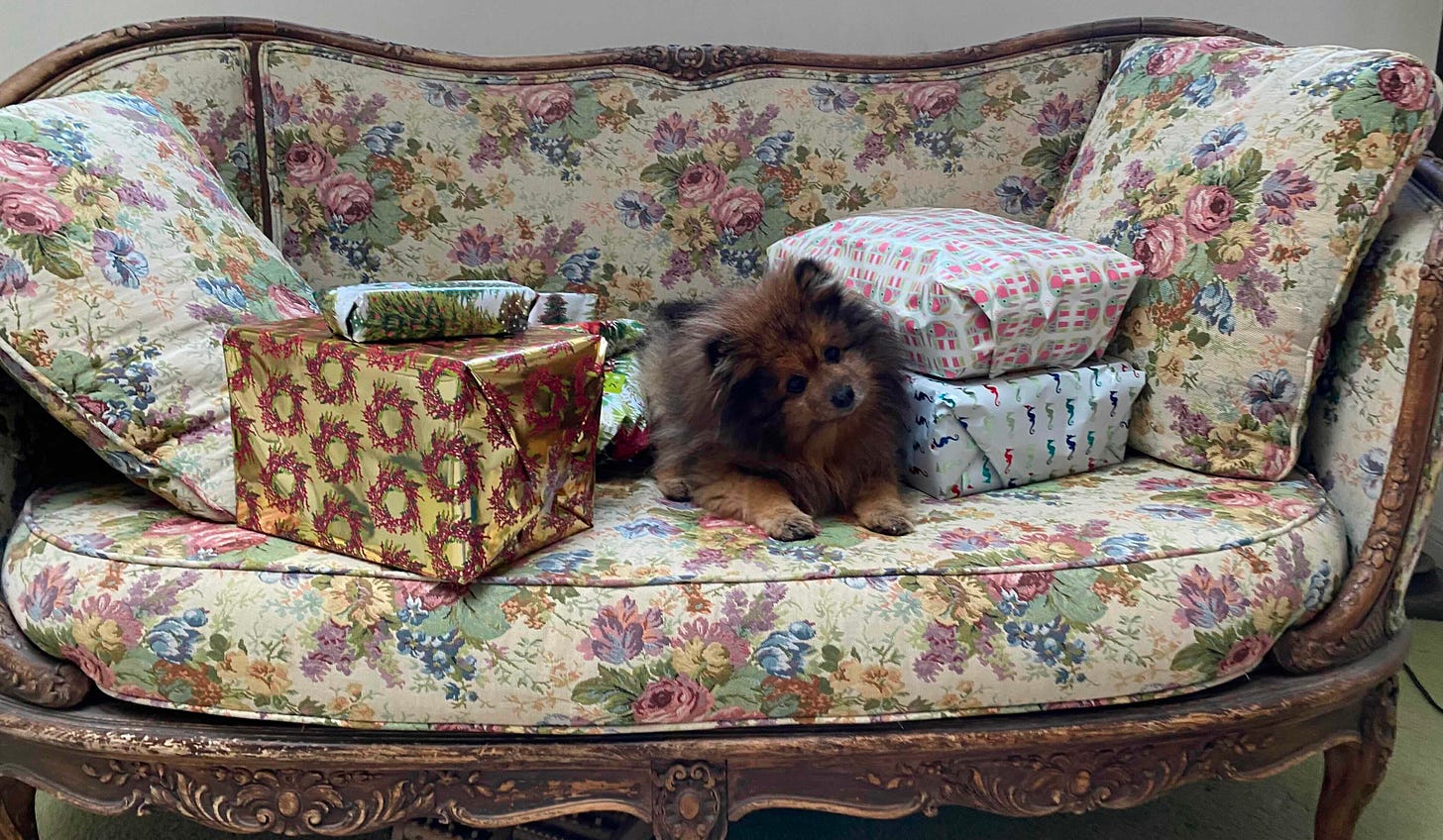
It was always fun to imagine the lives these pieces had before we got them. Who used these pieces before we did? What were their lives like? When you go into a museum, you can basically be sure that the pieces were used by kings, queens, and other members of the nobility.
So, you can clearly see the difference between the elaborate decorative arts on display at the Met, Getty, Louvre, etc. and the somewhat less special things that aren’t museum quality. What about the less rare and less ornate versions that find their way into antique malls and thrift stores? What lives did those objects lead? At the end of the day, everyone uses their couch to sit down on—and therefore, from the perspective of the couches themselves, the lives of one owned by a queen and another owned by a middle class merchant might have been pretty similar.
This line of inquiry brought more questions with it: are our possessions any less special to us even if they aren’t particularly “rare” or “desirable”? How does mass production factor into the discussion? Maybe such pieces are so special because someone made them by hand. But maybe that’s not why we appreciate them so much at all. My theory is that we like things because they set the stage for our lives, or, more probable, for the lives we aspire to lead.
Let’s take a pause from the philosophizing for a minute and get into some historical context.
The French Regency Period and its Decorative Arts
As it happens, there are a lot of surviving pieces from the French regency period, 1700-1730 ish. During this time period, home decor was more popular than ever, and people were drawn to intricate embellishments and whimsical shapes, a trend which further developed in the 1730s as the Rococo style more fully developed (and persisted through the 1770s or so).
While Regency and Rococo furniture is often associated with the royal family and court, the stylistic features of the time pervaded less luxurious/expensive/elaborate items as well: the things we see more like in antique stores and less so in museums.
You can see the similarities, but also the clear differences in quality between the furniture owned by the aristocracy and the furniture that might have been owned by more everyday types of people.
There are a lot of examples of couches from eighteenth-century France, and they really widely range in their quality, luxuriousness, and probable context. On the higher end of things, here’s a small loveseat/couch from the Louvre, for another example:
Here’s another example, rarer this time for its elongated form:
I especially love the roses and olive wreaths carved in gold on either side, and how the couch branches off on either side to make almost like two independent chairs. You can get close—but, critically not too close!—to the others on the couch.
Now, obviously, the piece gifted to my father were not museum quality, and it seems like maybe the cushions and such had been replaced since the early 1800s (unless they were somehow in remarkable condition? I never asked). As noted above, there’s a clear difference between the types of things a museum is interested in displaying and the types of things that the rest of us would be able to acquire. Indeed, you might be surprised to learn that, for really not too much more money than modern furniture costs, you too could decorate your home like 1700s/1800s France—and have the bragging rights that you don’t just have furniture in your home, you have a decorative arts collection. The dream!
Take, for instance, this eBay find, one of many settees, yours for $1295 plus shipping from Pennsylvania:
In all these examples, despite being of greatly varying quality and degree of luxury, you can see the puffiness of the cushions and how the designs take their inspiration from the natural world. This style, as a result, has a lighthearted sort of look to it. Even when you’re inside, the tranquility of the natural world comes into the space.
Enough of couches for the moment. Decorative arts don’t even need to be that decorative: they can be plainer in their style as well. Maybe this solid wood armoire (c. 1800) would look perfect in your room:
As you can see, there’s a distinctive shape with French antiques from the eighteenth and early nineteenth centuries: the curving lines of the silhouette, the uplifted corners of the carving, the fluted styling of the decoration.
For me, and probably for most of us, acquiring antiques/decorative arts isn’t in the budget at the moment. But I’m still fascinated by the way in which styles circulate and sort of trickle down from the “designer” to the “fast fashion” versions, even in the world of furniture and utensils.
For example, there are parallels in shape between our (relatively) humble eBay armoire and this extremely ornate armoire-bookcase from the Louvre:
The angled top and the curving, fluted lines of both pieces make them visually similar even if the material and degree of decoration really couldn’t be more different. Why do we need a gilded armoire? We really don’t, obviously. That’s not really my question, though. Of course if a gold wardrobe/bookcase is within your means, you absolutely should go for it. What I mean is that maybe we could look back at the plain wood wardrobe (or whatever your wardrobe/dresser looks like) and see the artistry of the lines there, the simple elegance of the leaves subtly carved across the top. Maybe you could shift your eye and see IKEA or Way Fair furniture or something you got on a Free and For Sale page as art too. Maybe not in the way they actually look, but in the way you use them to adorn your space, to have a presence in your home not just as functional objects but contributing parts of the overall aesthetic of the room. The label “art” comes from our own discernment, not the objects themselves.
To conclude, I’ll go back to the opposite end of the spectrum, just for fun, and leave you with Marie Antoinette’s jewelry case (serre-bijoux)
Once again, we have a strong evocation of the outside world and the curving and fluid lines of nature, and there’s also a neoclassical element to it too. The four women serving as pillars (known as caryatids) seem like guardians of the queen’s treasures, while also signifying her command of culture and love of the arts.
This particular cabinet has a fascinating history. After leaving the chambers of Marie Antoinette, it went to the château de Saint-Cloud and then to the château de Compiègne to be in the music room of Empress Eugénie, wife of Napoleon III. In other words, it was originally intended to be in a private bedroom, used for jewelry. In the nineteenth century, however, it was put in a music salon, where I’m assuming Empress Eugénie did not necessarily keep her jewelry. At that point, it would have been valued for its history and the prestige it had for once being Marie Antoinette’s: another layer to the “artistry” of this already-stunning example of decorative art. It’s not just about the decorations: it’s about the life the object has led, and the people with whom it came into contact.
Thank you for reading this week’s newsletter!
Maybe my HomeGoods furniture isn’t on par with a solid gold-adorned jewelry cabinet or gilded armoire, but the way we decorate our spaces has a lot of the same significance to us in our everyday lives as it did to the lords and ladies of the past. Still, I’ll be checking out antique stores with an extra careful eye, just in case it’s ever me who gets to discover a rare treasure from a palace. Take care until next time.
MKA

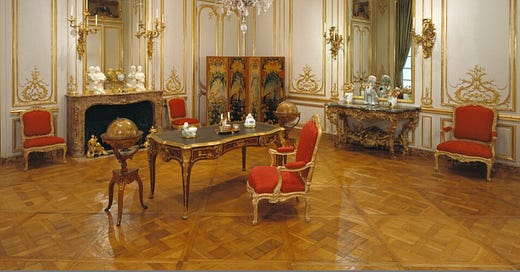




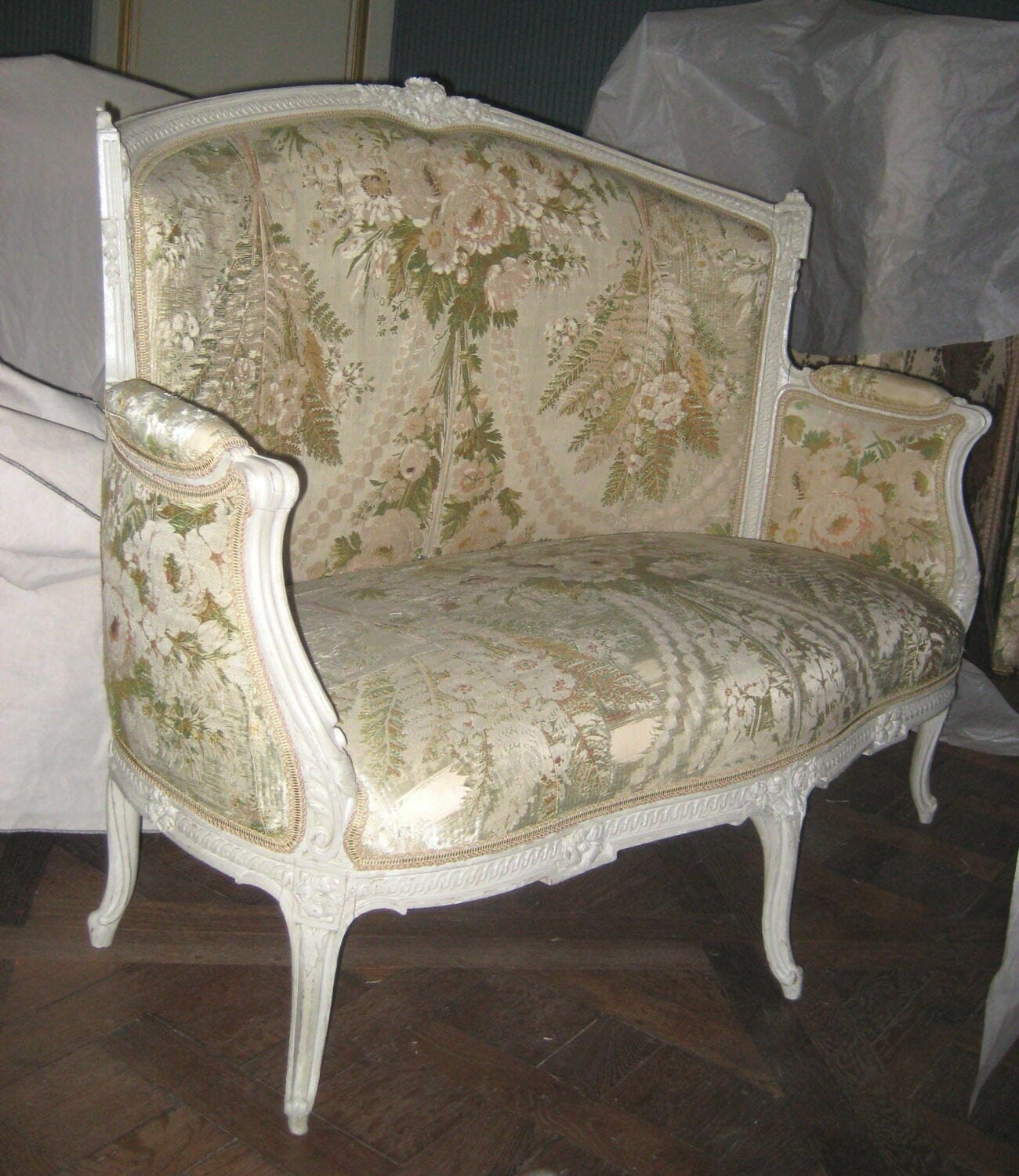
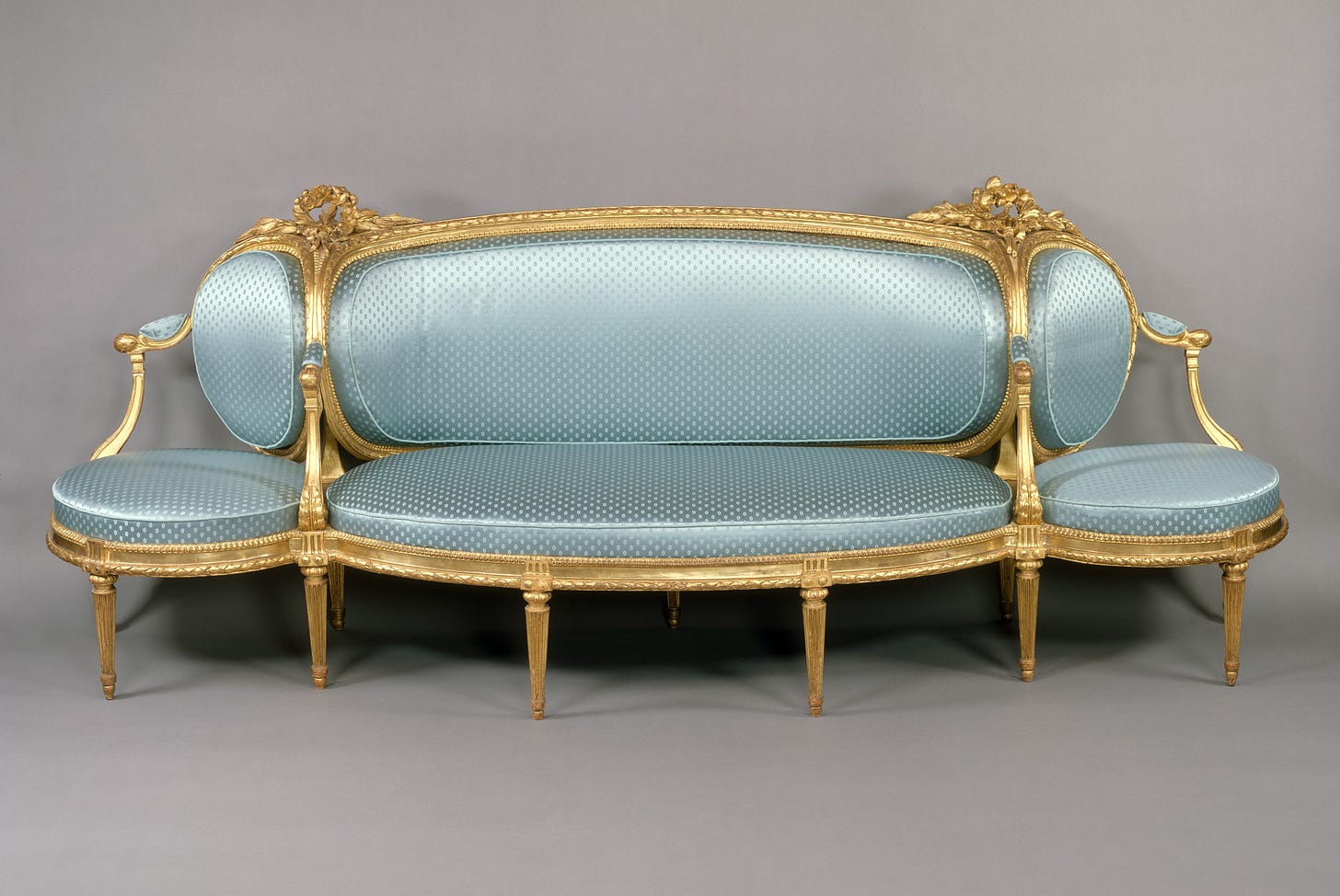



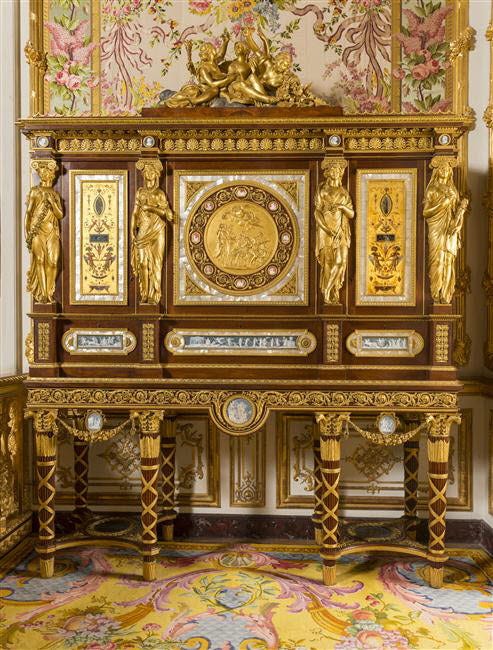
Was a special joy to read this and recognize scenes from the Getty!